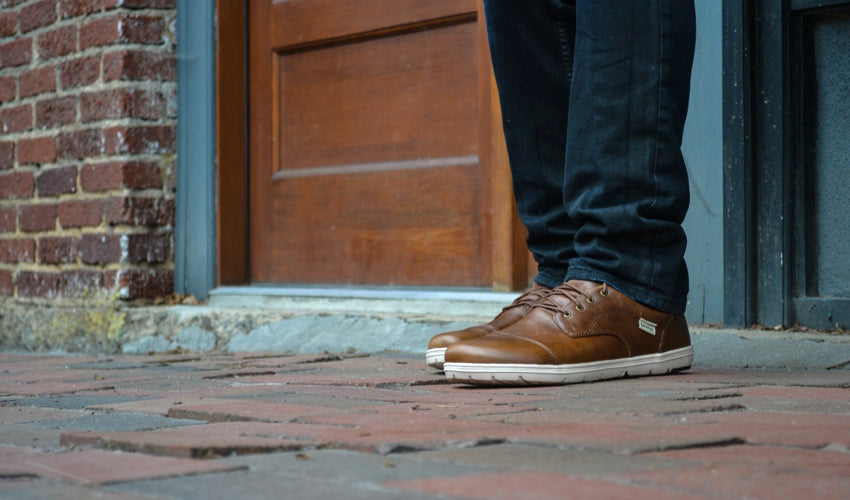
Selecting foot-healthy shoes—shoes that truly support long-term foot health—is one of the most important considerations in caring for your feet, as most foot and toe problems are caused by conventional footwear. Indeed, shoes that are generally regarded as appropriate (and even healthy) by many foot care professionals and society at large actually cause a variety of foot and toe deformities and lead to numerous musculoskeletal health problems, from bunions to hammertoes to ingrown toenails to knee osteoarthritis.
But how do you know which shoes will help you achieve optimal foot health and which ones will cause problems? In this article, we have compiled some helpful tips to help you differentiate between shoes that will improve your foot health and shoes that will hinder it. Our top tips for selecting foot-healthy shoes are:
- Avoid shoes with design flaws
- Take stock of toe box width & shape
- Use Correct Toes as a guide
- Perform the Shoe Liner Test
- Plan ahead for foot lengthening
- Understand natural foot anatomy
Let's delve into each of these tips a bit more to gain a greater understanding of how they relate to natural foot health and shoe selection.
Tip #1: Avoid Shoes with Design Flaws

Four main design features found in conventional footwear—including shoes and boots, and many sandals—are responsible for the bulk of negative foot health effects that occur over time: Heel elevation, toe spring, tapering toe boxes, and rigid, inflexible soles. Shoes or boots that possess these injurious design elements represent the majority of footwear sold today, though an increasing number of footwear companies are producing more healthy-foot-shaped, minimalist designs that incorporate less (or no) heel elevation, wider toe boxes, and more flexible soles. Please see our men's and women's shoe pages for examples of such footwear.
For a more comprehensive list of common footwear design inclusions that can cause foot pain and problems, check out our article entitled Problematic Shoe Design Features. This article goes into greater detail about the many design aspects incorporated into conventional footwear that you should consider avoiding when selecting shoes. Sorting out the good from the bad is not terribly difficult once you know the potential pitfalls to look for in shoes. Still, if you have any questions about the foot-healthiness of any particular shoe brand or model, we welcome your questions and will do our best to provide helpful and relevant feedback.
SHOP MEN'S FOOTWEAR SHOP WOMEN'S FOOTWEAR
Tip #2: Take Stock of Toe Box Width & Shape

Toe box width is perhaps the single most important design element to consider when selecting footwear (though you could make a strong case for any of the design elements mentioned above in terms of importance for and impact on foot and toe health). A shoe’s toe box should accommodate natural toe splay and natural foot posture; that is, it should be wide enough to allow your toes to spread out the way nature intended, such that each individual toe is in line with its corresponding metatarsal bone.
In addition to toe box width, toe box shape is also an important consideration. The ideal toe box shape should resemble a reversed spade, such that the shoe is narrowest at the heel, sufficiently wide at the ball of the foot, and then becomes even wider out toward the ends of the toes. No part of a shoe's toe box should contact or encroach upon any of your toes, including, especially, your first and fifth toes, which are most vulnerable to the deforming effects of tapering toe boxes.
In terms of what's optimal for width in other parts of the shoe, a shoe can be on the snugger side around the heel and throughout the instep and still be perfectly foot-healthy. Most people need the width the most at the ends of the toes to preserve foot shape and function, and a good shoe accounts for this. For more information about shoe width and what to look for, please see our article entitled How to Determine Proper Shoe Width. Another article from our blog, called Shoe Sizing Techniques: Traditional vs. Natural, provides additional insights into the topic of shoe sizing.
Tip #3: Use Correct Toes as a Guide

One way to know for sure if a given shoe is wide enough in the toe box to accommodate natural toe splay is to try using the shoe in combination with Correct Toes toe spacers. We recommend Correct Toes as a tool to help reposition your toes in their normal (and natural) anatomical arrangement or orientation. You can wear Correct Toes throughout the day or as a night splint to help realign your toes and address or prevent foot problems. This toe spacing device works best (i.e., performs the most corrective work on the toes) when it's worn during weight-bearing activity, and it fits in certain shoe models, including all the options featured on our men's and women's shoe pages.
You can learn more about the many merits of Correct Toes in this article, entitled Top 10 Benefits of Correct Toes. This article, called Correct Toes vs. Other Toe Spacers, compares Correct Toes to other toe spacing devices available on the market. Note: It's important to avoid using Correct Toes inside shoes that possess any degree of toe box taper. Doing so will be uncomfortable and unproductive in terms of rehabilitating your toes and restoring optimal foot health.
SHOP CORRECT TOES

Another important thing to consider for foot health, and something related to getting the most out of your foot-healthy shoes, is sock tightness and the impact socks can have on toe position inside your shoe. Conventional socks, which possess a single sleeve that contains all the toes, may contribute to toe deformity and foot problems by pulling your big toe into a hallux valgus position, or a position in which your big toe is shifted toward your foot’s midline (also known as a “bunion configuration”). Consider stretching the seams of your socks, especially the seam that runs across the ends of your toes, to reduce their tightness. Or, best of all, buy socks that are less constricting, such as toe socks.
In our experience, we have found that a combination of Correct Toes, Injinji toe socks, Pedag metatarsal pads, and Naboso insoles produces synergistic foot health benefits. A truly foot-healthy men's or women's shoe should easily accommodate all of this helpful footgear, and the ability to do so is another indication of the effectiveness and appropriateness of a given shoe. Compared to conventional foot care approaches (i.e., surgery, injections, and orthotics), adopting and using these key pieces of natural footgear is a simple, economical, and effective approach to resolving many foot and toe problems.
SHOP INJINJI TOE SOCKS SHOP METATARSAL PADS
Tip #4: Perform The Shoe Liner Test

Getting a proper shoe-fitting from a trusted foot health professional (ideally, from someone with knowledge of normal foot anatomy and natural foot care approaches) is another important consideration when selecting foot-healthy shoes. Most people fail to get an individualized shoe-fitting and select shoes that are too narrow, especially in the toe box. If getting a proper shoe-fitting is not possible, you can assess almost any pair of shoes by performing the Shoe Liner Test to determine if they are sufficiently wide and appropriately shaped for your foot.
This test involves pulling the liner or insole out of your shoe and standing on it, with all your weight centered over your foot. If any part of your foot, including your toes, hangs over the margins of the liner, then the shoe is too narrow for your foot. When performed wearing Correct Toes toe spacers, the Shoe Liner Test is the gold standard for determining whether or not a given pair of shoes will help or hinder your foot form and function.
Tip #5: Plan Ahead for Foot Lengthening

Many people who make the transition to foot-healthy (and foot-shaped) minimalist footwear experience the phenomenon of foot lengthening over time. With external forces (such as tapering toe boxes and toe spring) that normally act to constrict the foot finally at bay, your foot will become longer and wider, eventually achieving its true length and width. It's not unusual for women to see a corresponding increase in shoe size, typically on the order of a half-size to a full size. Men often see even greater gains in shoe size; sometimes up to two full sizes beyond what they were originally wearing! This change doesn't happen overnight, but it instead occurs over a period of months and years, assuming you continue to use foot-healthy footwear and other natural footgear on a regular basis.
With this foot lengthening and widening in mind, you might consider purchasing a slightly larger shoe size to accommodate the coming changes, though nothing too drastic. A half-size up from your usual size is generally a good place to start. The slightly larger shoe size also means more roominess in the toe box, which is usually welcome, especially if you intend to pair your foot-healthy shoes with Correct Toes. You certainly want to avoid purchasing too large a size, as a lot of extra material past the ends of the toes makes for a sloppy feel and an increased risk of tripping or performing an errant footfall. We usually recommend leaving about one centimeter of space beyond the toes to accommodate some foot lengthening and toe unfurling.
Tip #6: Understand Natural Foot Anatomy

Caring for your feet involves selecting footwear that is shaped like how a human foot is meant to be shaped; that is, with the widest part of the shoe at the ends of your toes, not at the ball of your foot. Evidence of true human foot shape can be seen in newborns or in populations around the world—especially in Africa, South Asia, and Southeast Asia—who have largely gone unshod most of their lives. Many Nepali mountain porters, for example, prefer to go barefoot or wear just a thin, unobtrusive sandal when carrying their heavy loads. Porters' feet are strong and possess excellent toe splay, and foot health in this population is outstanding.
Your feet are inherently strong and resilient and, in most cases, do not require arch support, pronation control, or any of the other features shoe manufacturers have been touting for years. Observations of unshod cultures reveal the true depth of this statement: Populations who go shoeless or who wear minimalist footwear experience only a fraction of the foot and lower extremity problems that plague shoe-wearing populations. If arch support and other common conventional shoe design features are required for foot health, we would expect to find most of the developing world crippled with foot problems, which clearly is not the case. Understanding and accepting the true nature of human foot shape is a vitally important part of adopting foot-healthy footwear.
Anatomical Footwear for Improved Foot Health

Selecting the proper footwear, including shoes, boots, and sandals, is an important and constructive way to build strong, healthy feet and prevent more invasive foot or ankle interventions, such as surgery, down the line. Most immediate and long-term foot problems are preventable and do not require the use of conventional approaches (including arch orthotics or motion control footwear) to correct. Indeed, judiciously selecting footwear that protects your feet but still allows them to feel the ground and develop the flexibility they need is crucial in realizing optimal foot health and reclaiming your natural foot health heritage.
SHOP MEN'S FOOTWEAR SHOP WOMEN'S FOOTWEAR
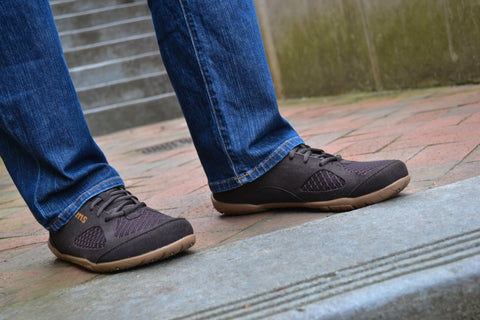 We all spend a lot of time on our feet, in shoes, so understanding what constitutes healthy footwear is absolutely crucial for building and maintaining optimal foot, toe, and joint health. Indeed, the health of your feet has profound implications on your entire body and your quality of life. But what are the key differences between a truly foot-healthy shoe and the industry standard? Quite a bit, as it turns...
Read more
We all spend a lot of time on our feet, in shoes, so understanding what constitutes healthy footwear is absolutely crucial for building and maintaining optimal foot, toe, and joint health. Indeed, the health of your feet has profound implications on your entire body and your quality of life. But what are the key differences between a truly foot-healthy shoe and the industry standard? Quite a bit, as it turns...
Read more











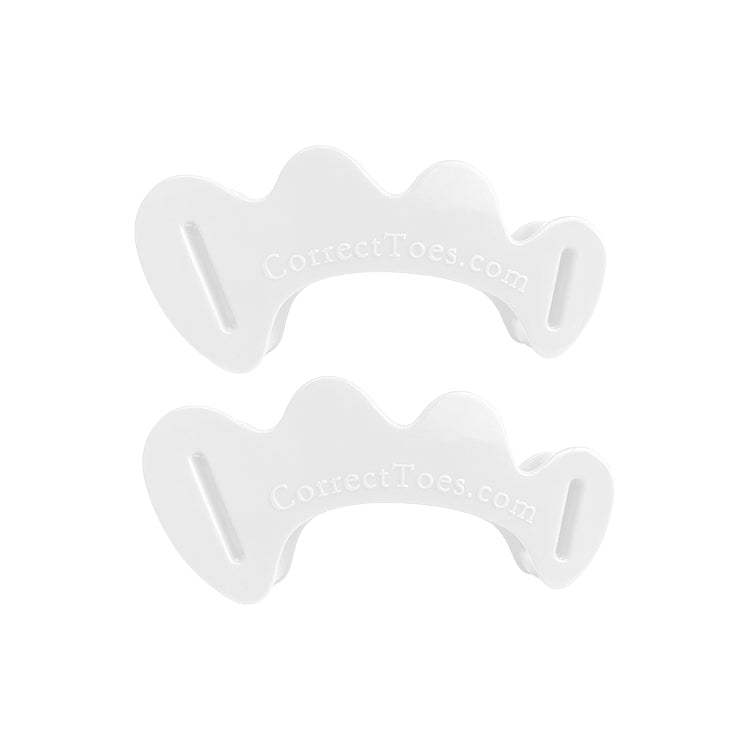

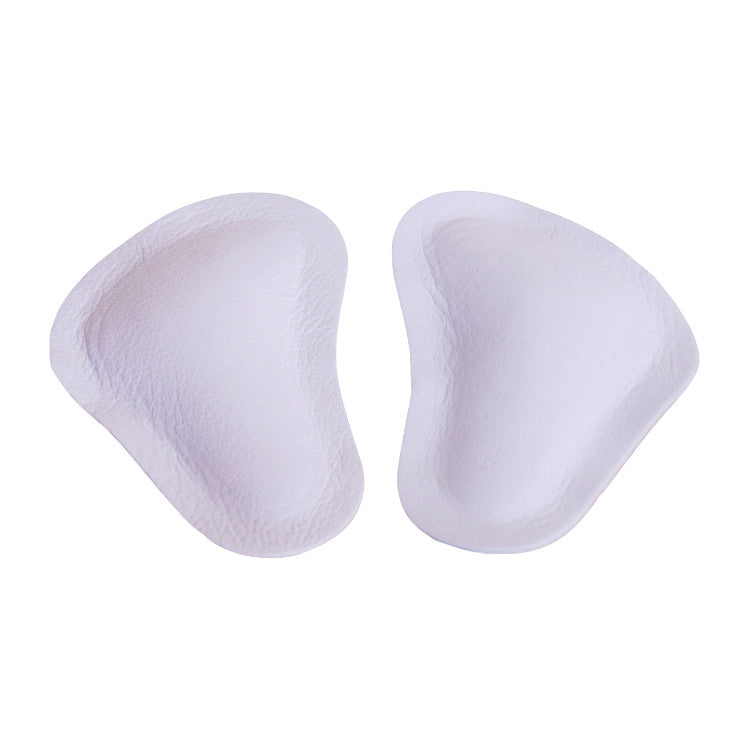



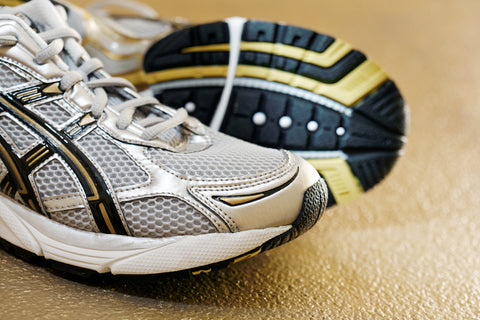


I am using Correct Toes and metatarsal pads and have wide toe box shoes plus toe socks. I have noticed a wonderful difference in freedom for my feet since May of 2014. Thank you for sharing your knowledge!
Hi, Christine,
Thank you so much for sharing your progress with us. We always love to hear about how the products we offer are helping people restore proper foot health. It sounds like you’re still early in the journey, and we hope you experience even more “ foot freedom” as you progress. Please keep us updated!
Thanks again for sharing this with us!
Kind Regards,
Andrew Potter
Which Natural Footgear-recommended shoe is best to start with when transitioning to minimalist shoes?
Hi, Sherry. Thank you for your question. It’s one that frequently comes up among visitors to the site who are looking to make improvements to foot form and function. In our experience, we’ve found that the best shoe to start with when transitioning to minimalist shoes depends on various factors, including your foot shape and volume, your current level of activity, and any existing foot conditions you might have (as well as how long you’ve worn conventional footwear). However, popular choices for beginners transitioning to minimalist footwear include the Lems Primal 3 (formerly Primal 2) and the Xero Kelso:
• Lems Primal 3: www.naturalfootgear.com/pages/lems-primal-3-shoes
• Xero Kelso: www.naturalfootgear.com/pages/xero-kelso-shoes
Both models provide a wide toe box, flexible sole, and minimal (yet sufficient) cushioning, which can help your feet adjust gradually to the new barefoot-like experience while still offering some protection. They also work well in combination with Correct Toes and other helpful footgear. Of course, it’s essential to start slowly and then gradually increase your time wearing minimalist shoes to allow your feet and musculoskeletal system the chance to adapt properly. Additionally, consulting with a natural foot health specialist (if you have access to one) can provide further insights about your specific needs and circumstances.
We hope this info helps! Please let us know if you have any follow-up questions.
Yours in Foot Health,
Drs. Marty & Robyn Hughes
I was always under the impression that minimalist shoes were for extreme barefoot types. But lately, I’ve been wondering if I’m wrong about this. What’s your perspective here? What things do most people get wrong about minimalist footwear?
Hi, Jaden. Many thanks for your thoughtful questions!
At Natural Footgear, we believe in empowering individuals to make informed decisions about their footwear. One of the most common misconceptions people have about barefoot or minimalist shoes is that they are only for people who are already accustomed to walking or running barefoot. Many assume that switching to minimalist shoes will be uncomfortable or even harmful. In reality, these shoes are designed to support natural foot mechanics, not to force a specific way of moving. While it’s true that transitioning to barefoot or minimalist shoes can require an adjustment period, most feet will ultimately find a comfortable home in this “less is more” style of footwear. Our feet are incredibly adaptable, but like any other part of the body, they need time to strengthen and adjust when switching from conventional shoes with built-in cushioning and arch support.
Another widespread myth is that minimalist shoes don’t offer enough protection or durability for everyday use. This misconception often stems from the belief that because minimalist shoes have thinner soles, they are more susceptible to wear and tear or lack protection from the elements. In fact, many minimalist shoes are made from durable, high-quality materials that are specifically designed to provide adequate protection without compromising on flexibility or foot health. The soles are typically crafted to offer just enough protection from rocks, sharp objects, and rough terrain, while still allowing the foot to move naturally and feel the ground beneath it.
A third common myth is that minimalist shoes are only suitable for running or outdoor activities. While many minimalist shoes are excellent for running, particularly for those looking to improve posture and form, they are also highly versatile for everyday use, whether for urban outings or even office wear. In fact, many minimalist shoes are designed with aesthetics in mind, offering a sleek, modern look that pairs well with a variety of outfits. The benefits of minimalist footwear aren’t limited to athletic or recreational activities; they can promote healthier feet and better posture throughout all aspects of daily life.
Lastly, some people believe minimalist shoes are a “one-size-fits-all” solution. The reality is that foot anatomy varies widely from person to person, and what works for one person may not work for another. That’s why we at Natural Footgear emphasize the importance of finding the right fit, understanding your unique foot structure, and incorporating a variety of helpful footgear into your daily foot care routine. Different minimalist shoe brands cater to different needs—whether it’s a wider toe box, a more flexible outsole, or varying levels of cushioning. It’s crucial to take the time to assess your feet, how you move, and what feels most comfortable for you as an individual.
At the end of the day, barefoot and minimalist shoes are about reconnecting with natural movement patterns and supporting long-term foot health. However, it’s important to approach the transition thoughtfully and with patience. When done properly, minimalist footwear can offer a range of benefits, from improving foot strength to promoting better posture and overall mobility.
We hope this answer helps, Jaden! If you have any follow-up questions, please don’t hesitate to reach out.
Yours in Foot Health,
Drs. Marty & Robyn Hughes
I found out recently that I will be a grandmother in a few months! Will you be planning on adding any shoe/boot recommendations for toddlers, children, and youth on your wonderful website? I have learned such helpful information from Natural Footgear and have been getting positive results from wearing Correct Toes and proper footwear consistently. Thank you for all that you do.
Hello, Donna,
Thank you for your comment. Congratulations on the upcoming addition to your family! We’re so happy to hear that you’ve found our resources helpful. While we currently focus primarily on adult footwear, you can find some recommendations for children’s shoes here:
www.naturalfootgear.com/collections/kids-shoes
Children’s feet develop so rapidly, and it’s important to choose footwear that supports healthy growth. We’ll keep adding recommendations to the above page as more foot-healthy options for kids become available!
All the best,
Robyn Hughes, ND
I’m happy with the durability of my flexible, flat-soled footwear, but how do I know when it’s time to replace my minimalist shoes?
Hi, Rob. Thank you for your question! A key benefit of minimalist footwear is its durability—thanks to their simple yet robust design, many pairs can last for years with the proper care. However, just like any well-loved tool, minimalist shoes don’t last forever. The challenge is that, unlike traditional footwear with thick foam midsoles that visibly compress or break down, minimalist shoes often wear out in less obvious ways. Knowing when to replace them requires paying attention to subtle changes in function, fit, and overall comfort.
First, assess the outsole. Minimalist shoes typically feature a thin but grippy rubber sole, designed to provide just enough protection while allowing maximum ground feel. Over time, the tread may wear down, especially in high-contact areas like the ball of the foot or the heel. If you notice excessive smoothing of the sole, reduced traction, or small punctures or cracks, your shoes may no longer offer the protection you need. This is particularly important if you frequently navigate rough or varied terrain.
Next, pay attention to how your shoes feel while walking, running, or standing. One of the best indicators of wear is a change in sensory feedback. If the sole has thinned significantly, you may feel sharper pressure from rocks, roots, or pavement than you once did. Additionally, if your shoes develop asymmetrical wear patterns, you might notice subtle changes in your gait—an early warning sign that your footwear is no longer supporting natural movement as effectively as before.
Another crucial factor is the structural integrity of the upper. While minimalist shoes are designed to be flexible, excessive stretching or fraying can compromise their fit. If the upper has become overly loose or has developed holes that let in more debris than usual, it might be time for a replacement. A poor fit can lead to unnecessary foot strain, as your toes and arch may have to work harder to compensate for the shifting in-shoe environment they encounter.
Ultimately, the decision to replace your minimalist shoes comes down to how they feel and function in your daily life. If they no longer provide the protection, traction, or fit you need to move comfortably and confidently, it’s likely time for a new pair. That said, because minimalist footwear encourages foot strength and resilience, your feet themselves may adapt over time, requiring less from your shoes. Trust your own experience, and when in doubt, test a fresh pair—if the difference is striking, it’s probably time for an upgrade.
Yours in Foot Health,
Drs. Marty & Robyn Hughes
I’m curious about the future of footwear. Do you think that advanced materials or wearable tech could enhance natural foot health without restricting function?
Hi, Micah. Thank you for your question! The future of footwear is an exciting frontier, and advances in materials science and wearable technology certainly hold promise—but only if they respect the foot’s natural structure and function. Innovations like ultra-lightweight, flexible materials, adaptive cushioning, or breathable, durable fabrics could enhance comfort, reduce unnecessary strain, and even support proper foot mechanics. Imagine soles that adjust dynamically to terrain or insoles that provide gentle, targeted feedback to encourage healthy toe splay and arch engagement. The key, however, is that these technologies must work with the foot, not impose artificial control or restrict natural movement. Any “enhancement” that compromises the foot’s intrinsic ability to stabilize, sense, and propel itself ultimately undermines foot health rather than supporting it.
In practical terms, the most exciting developments will be those that complement natural biomechanics rather than replace them. For example, sensors could monitor gait patterns to alert wearers of asymmetries or emerging strain, while materials could shield and support the foot in dynamic ways without constraining natural toe movement or altering the foot’s innate mechanics. Footwear that encourages natural motion, maintains proper alignment, and allows the intrinsic muscles to strengthen will always outperform even the most advanced tech that prioritizes shock absorption or aesthetics over function. In short, the future of foot-friendly footwear lies in combining innovation with the timeless principles of natural foot form and function—creating shoes that empower the foot rather than inhibit it. We hope this answer helps! Let us know if you have any follow-up comments.
Yours in Foot Health,
Drs. Marty & Robyn Hughes